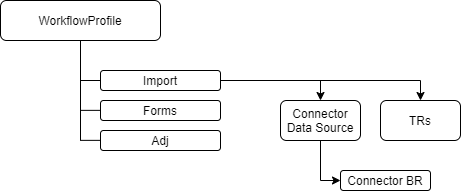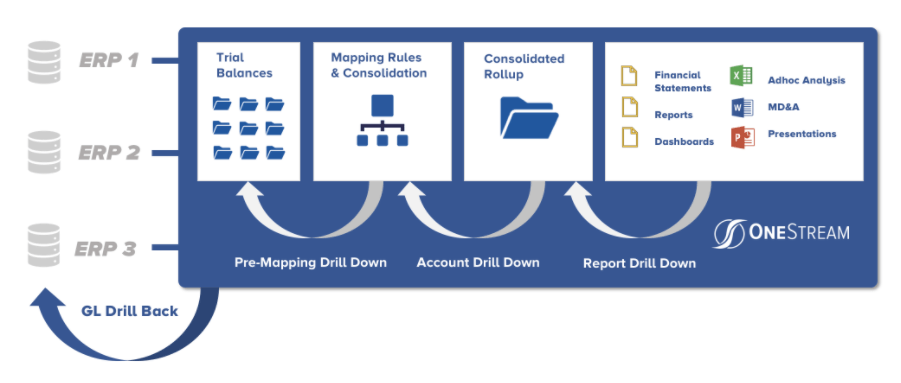SAP Discontinues Maintenance, OneStream Rides in as a White Knight
As a company, CFO, or large enterprise that has used SAP (ECC or SAP S/4HANA) and seen the future development of the multitude of potential SAP products and the forced migration to a flawed product, your most pressing question may be:
"How on earth can we extricate ourselves from this web of software dependencies and still access and integrate our data cost-effectively?"
OneStream, to many, is a ‘white knight’ riding into the fray of business corporate performance management legacy systems. It provides a unique ability to ensure data quality and enhanced financial reporting analysis while still offering drill-back capabilities to transactional details. Often the OneStream integration with SAP is more straightforward than using SAP CPM solutions, such as BPC. The following data integration illustration shows why over 100 SAP ERP clients have made the switch to OneStream.
Harmonious Integrations
OneStream allows a simple and harmonious integration with SAP (ECC or S/4HANA) in any of their versions. Communication can be direct with the ERP and Integration Servers such as SAP PI, SAP PO and SAP Cloud Platform Integrations. OneStream can adapt its interfaces depending on the client's SAP service architecture.
The most common integration plan includes direct connection. This simple solution is meant for non-complex SAP architectures. Its data integration is an easy two-way communication:

However, if your data methodology uses an SAP server, the integration becomes a three-layer process through an SAP integration server or SAP SCPI, which looks like this:

These standard frameworks can use a variety of different protocols but offer easy and simple solutions to ensure quick data transfer and easy data integration into the OneStream platform.
Flexible Protocol Use
One of the reasons integrations are possible is OneStream's ability to use multiple data-call protocols to match your software dependencies and needs. There are a variety of protocols to integrate OneStream with SAP; the following are the most frequently used:
REST
Representational state transfer (REST) is the most used protocol for these integrations, using HTTP requests to access and consume data. REST makes it easy to call data from various platforms and transfers pure human-readable data in JSON or XML. REST makes the business data self-explanatory and easy for laypersons to understand. Any device which can listen and speak HTTP can consume SAP Data through this protocol.
SOAP
One of the newer technologies for connecting to SAP architecture is the Simple Object Access Protocol (SOAP). This protocol is a pure web technology and can call functions using the HTTP protocol. Remote function calls (RFC), SAP interfacing communication between their systems, are also made available via the SOAP interface.
RFC
The traditional way for communication between non-SAP systems and SAP is, according to SAP itself, the RFC interface. RFC interfaces are also often used to communicate between SAP systems themselves. Put simply, RFC is a remote function call. OneStream connectors are allowed to consume an SAP RFC.
With multiple options to integrate and secure data transfer between existing SAP architecture and OneStream, moving away from outdated technology and software systems is easier and more cost-effective than you may think.
Building Data BR-idges in OneStream
Once data connections are established with your existing SAP architecture, accessing your data is a comprehensive process that matches your Connector Business Rules (BR) to OneStream data fields to import, integrate and stabilize your data within OneStream.
OneStream data quality starts with a simple workflow setup that matches business rules for new or existing data fields and ensures full compliance within your current data organization. The following workflow chart shows the building of our BR-idges to your SAP data:

The logic required for this data conversion follows your Connector BRs as previously established and follows data logic pathing.

After the DataTable object is populated, we can refine the data or use LINQ to add additional logic. The last step is to pass the DataTable as an argument to the OneStream function: API.Parser.ProcessDataTable().
OneStream's data integration capabilities span many different types of data, including:
- Trial Balance Summaries
- Transaction Detail
- Statistical/Non-financial Data
- Employees, Jobs and Positions
- Leads, Opportunities
- Users and User Security
- Chart of Accounts
- Dimensional Hierarchies
- Operational Metrics
- Currency Rates
Any data can be pulled from SAP that may be required to facilitate Financial Reporting or Planning processes in OneStream. The power of this process is further enhanced by OneStream's native drill-back and drill-through capabilities.
Drilling to the Heart of the Data
Comparing, qualifying and validating transactional data in other financial reporting software suites requires you to open another third-party application to drill-back or through to the original values. OneStream provides this within its platform, saving you a considerable amount of time.
The following diagram outlines how data is gathered, mapped, consolidated, integrated and provided to support your business reporting and analytics while still giving you drill-back and drill-through transparency.

In OneStream, your financial data is accessible and visible through every stage from its creation point to reporting. Even more important is integrating your data from legacy or disparate systems such as SAP and other ERP, CRM, GL, and HCM environments. This integration offers you business intelligence reports that are more accurate, automated and instantly available in real-time. Fully integrating your data across these various systems will allow you to reduce errors and inefficiencies, as seen above in the extensible Connector BRs, and enable your teams to make SmartCPM decisions.
I look forward to providing more in-depth tech tips and commentary on OneStream and its advantages in the months to come.
If you would like more information on OneStream or Ascend Partners, a globally renowned architect and implementation team, contact us today.
SOURCES:
https://www.onestreamsoftware.com/platform/financial-data-quality-management
https://blog.onestreamsoftware.com/why-onestream-is-the-proven-alternative-to-sap-bpc
https://www.us-analytics.com/onestreamblog/onestream-xf-questions
https://cpminsights.com/2020/01/14/add-external-database-connection-in-onestream-quick-tip-5/
https://www.syntax.com/whats-the-difference-between-sap-ecc-sap-hana-and-sap-s-4hana/
Ascend Partners Technical Team, "SAP Connector Business Rules Brief," Internal Brief, February 2021.
Ascend Partners Technical Team, "SAP OS Data Integration Brief," Internal Brief, February 2021.

